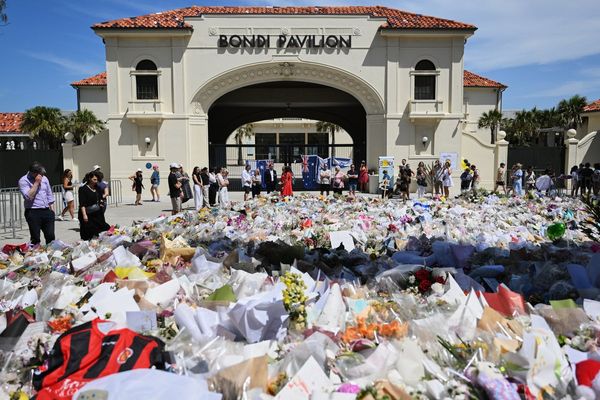
Staff and former board members at Sydney’s Powerhouse allege the museum’s collections have been neglected and put at risk of damage, as Australia’s flagship science and technology museum undergoes a controversial $500m conversion into a commercially driven creative arts and events space.
Guardian Australia has spoken to multiple members of staff who have have shared their concerns that the upkeep on the historic buildings in Ultimo appears to have been neglected and the quality of programming downgraded in order to smooth the way for its conversion into what the previous New South Wales government touted as a “creative industries precinct”.
In addition, staff, former board members and volunteers at the museum have alleged that objects in the museum had been placed at risk during major modifications to exhibition spaces and at parties and events held at the site, and that unrectified leaks in the building had threatened exhibits.
One former Powerhouse board member told the Guardian the museum had been reduced to “a half-empty neglected mess”, while a written statement from the museum board’s former long-serving president, Nick Pappas, accused the former state government of conducting “a miserable land-grab under the guise of supporting the cultural needs of western Sydney”, resulting in the “unjustified and catastrophic destruction of a beloved and award-winning public edifice and cultural institution”.
In coming weeks, the majority of Powerhouse staff will be relocated from the Ultimo site to the institution’s storage facility at Castle Hill while a new Powerhouse museum is built in Parramatta – a $915m project scheduled for completion in 2025.
On Wednesday, the Guardian revealed heritage architect Alan Croker’s allegations that the former NSW government had “buried” his company’s work on a conservation management plan (CMP) for the Ultimo museum after it found the entire site should be heritage listed.
Such a finding would have prevented the government’s plans to demolish at least one-third of the museum’s existing buildings and significantly modify others.
‘You just don’t believe what you’re looking at ’
The Powerhouse’s new direction – fashion and design over science and technology, and moving away from the family market – is well under way. Its current exhibitions include Unpopular, about the 1990s alternative music scene; a Carla Zampatti fashion retrospective; an exhibition featuring new Australian designers; and Absolutely Queer, which shines a spotlight on Sydney’s leading LGBTQI+ creatives.
While the former power station in Ultimo became home to the Museum of Applied Arts and Science’s extensive science and technology collection 35 years ago, the Powerhouse no longer has a curator of transport and engineering, or aviation. In February, “museum” was formally dropped from the institution’s title.
Staff who spoke to the Guardian said they believe the institution’s focus has noticeably shifted over the last five years towards prioritising commercially driven arts events.
Questioned in budget estimates last September, the Powerhouse’s chief executive since 2019, Lisa Havilah, put forward a business case for the Ultimo and Parramatta operations combined at $38.8m in commercial revenue per annum by 2028 – $10m more than the National Gallery of Victoria, which is currently the most visited museum in Australia.
Kylie Winkworth, who sits on the board of the National Trust (NSW) and is a member of the Powerhouse Museum Alliance, a group fighting to save the Ultimo site as a museum, said she believed the business case showed that the museum’s management and trust no longer regarded the Powerhouse as a public museum and it had already transitioned into a “commercially focused events business with some museum exhibitions fitted in around gaps”.
“If this is the future of the former Powerhouse museum, the new government should be reviewing the former government’s scheme to turn a once popular family museum into a place for parties, pots and frocks under the banner of ‘Ultimo renewal’,” she said.
“The museum has become a half-empty neglected mess.”
Some staff and volunteers have shared their concerns that objects still at the Ultimo site have been placed at risk during public events and parties, providing photos that show revellers consuming alcohol and food while milling around exhibits.

In December, staff reported internally that one of the museum’s signature exhibits, a 1950s Catalina seaplane that made the world’s first crossing of the south Pacific, had been damaged with almost one metre of white spray paint. The damage had been done “intentionally” and “some time over the last couple of days or possibly weeks”, a staff member reported.
The Catalina had been suspended 10 metres above the Boiler Hall for more than three decades before being lowered to the floor last August into a large space now used for evening functions.
When asked by the Guardian, a Powerhouse spokesperson said the museum’s conservation department investigated the claim and it was determined the paint was “damage done before the object was acquired”.
The “highest level of care and protection” was ensured when functions were held at the Ultimo site, the spokesperson added.
The aircraft was acquired by the museum in 1961 and was fully restored before its suspension from the ceiling in 1987.
Dr Lindsay Sharp, who served as founding director of the Powerhouse in the 1980s before going on to become the director of the UK’s sprawling network of science museums, said he was astounded by photos he had seen of parties held at the Ultimo site.
“You’re looking at absolutely irreplaceable, iconic objects,” he said. “Of course there is a way of opening up exhibits for the public to get up close to, but it has to be done in a professional way. As a museum director, as a museum professional, you just don’t believe what you’re looking at here.”
The cavernous transport hall where the Catalina seaplane is housed was gutted in mid-2021, with most of the museum’s extensive transport collection – including an early 20th-century Bleriot monoplane, a 1904 motorcycle, a 1939 Chevrolet, a Victorian boneshaker bicycle and an 18th-century sedan chair – now removed.
Staff also shared photos of large glass and steel display cases being dismantled with angle grinders while prized exhibits, such as the fragile Bleriot, were left uncovered and risked exposure to industrial dust, which has the potential to damage machine parts and corrode surfaces.

After the museum’s former head of conservation, Pat Townley, was shown images taken by staff during the hall’s dismantling, she issued a statement to the Powerhouse Museum Alliance. “The management approach adopted for the dismantling of the major part of the transport exhibition seems to have seriously neglected the need for risk mitigation,” she wrote. “The failure to properly protect objects during dismantling of exhibition spaces demonstrates total disregard for well established collection management principles.”
One staff member said conservation staff had raised concerns with Havilah over the lack of protection to exhibits during the dismantling.
“As curators, we must uphold best practice for the long-term conservation of our objects,” the staff member said. “Many have been donated, or acquired through purchase, and there is an expectation they will be carefully looked after, but we’ve seemed to have lost that.”
The Powerhouse spokesperson said museum conservators had monitored dust levels throughout the works.
“All work undertaken across the museum is led by the museum’s professional conservators and curators to ensure the care and safety of the collection at all times,” she said.
Staff also alleged that leaks in the museum’s ceiling had put some exhibits at risk. Textile exhibits were sheathed in plastic in September last year when rain began entering the building. Staff shared images with the Guardian of water damage on the walls of the Boiler Hall and near the 1785 Boulton and Watt, one of only three surviving working steam engines in the world.
In March last year Havilah told the government’s museum inquiry that “unfortunately we have leaks in our roof and [the museum] does need a very significant upgrade”.
“Leaks in the roof do not justify the spending of $500m, does it?” asked the inquiry chairperson, Robert Borsak, challenging the overall cost of the Ultimo redevelopment.
“You’re getting the wrong roofer,” Greens MP David Shoebridge said.
Minutes from an April 2022 board meeting reveal that repairs for the leaks had been described as being “not possible due to budget constraints”.
When asked if any items in the museum’s collections had been damaged by water, the spokesperson did not respond, instead saying maintenance to address leaks was ongoing “to ensure that exhibitions are protected in response to detailed risk assessments”.
‘A recipe for fewer exhibitions of limited appeal’
A survey of Powerhouse staff completed in late 2022 found that two-thirds of respondents believed the museum was no longer providing a good experience to visitors.
The People Matter survey – which all NSW government departments are required to complete annually – revealed a lack of confidence in senior management, with more than two-thirds of staff saying they believed no action would be taken by management on the survey results.
The Powerhouse spokesperson said a presentation was provided to all staff “identifying priority areas to address and areas of improvement” after the survey results came out, and a new position of employee experience manager had been created.
According to the latest annual report, 178,895 people visited the Powerhouse in 2021-2022, a 62% drop on pre-Covid numbers and a figure that included about 9,000 people who attended functions unrelated to any exhibitions. Although the hangover from lockdowns undoubtedly contributed to the drop, by way of comparison, the Australian Museum, which was once considered the Powerhouse’s fusty poor relation, had 510,000 visitors over the same period.
“All the performance metrics indicate that the [Powerhouse] museum’s focus on creative industries, fashion and design is a recipe for fewer exhibitions of limited appeal, declining visitors and collapsing education outcomes,” Winkworth said.
During the state government’s 2019 inquiry into museums and galleries, former Powerhouse board member Janet McDonald told the inquiry she believed the museum had begun to deteriorate at some point between the end of her first tenure as a director in 2003 and her reappointment to the board in 2016.
When she returned, about 12 months after it was announced the museum would move to Parramatta, she told the inquiry she was “shocked by the state of the museum”, adding: “It is a shell of itself.”

An anonymous former Powerhouse maintenance employee, only identified as Witness C, testified to the inquiry in February 2019 that when he joined the museum in 2016 he noticed “a lot of lax maintenance”.
“The attitude of keeping the place looking good is one of the things you should be doing, and not having the place look like you are saving money by not replacing things and letting it look half-arsed,” Witness C said.
A second anonymous former Powerhouse employee, identified as Witness B, testified to the inquiry in February 2019, saying they believed “there has been a major focus on the latest, the hippest, the fashionable. The core audiences of family, schools and older visitors have been mostly neglected. Long-term dedicated, professional staff have been ignored and sometimes scorned.”
Witness B alleged that, in the years up to the end of 2018, they had personally heard members of “the past and current executive” who publicly supported the decision to move the museum, make comments in private including “most of the collection is uninteresting”, “history is boring”, “community consultation is a waste of time; we’re just ticking the boxes” and “we’ll use the Boulton and Watt engine to run a designer brewery”.
“Really, this is what staff have had to endure in recent years,” Witness B said.







